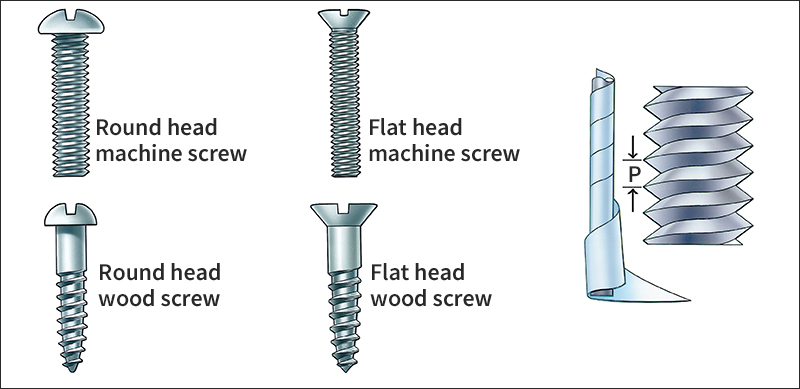Screw is an inclined plane wrapped in a spiral around a shaft. The screw is one of the six simple machines developed in ancient times. The other five are the lever, the wheel and axle, the pulley, the inclined plane, and the wedge. See Machine (Six simple machines) .
A screw consists of two main parts—the body and the thread. The body of a screw may be a cone or a cylinder. The center line of the body is called the axis. The thread is the inclined plane that sticks out from the body. The distance between two adjacent (neighboring) crests of the thread is known as the pitch.

Uses.
Screws have many practical applications, especially as fasteners. The most common are the wood screw and machine screw. When rotated, such screws can be made to move into, or out of, an object. As the screw rotates one full turn, it travels a distance equal to its pitch. Most wood screws and machine screws have a slotted or recessed head into which a screwdriver is placed in order to turn the screw. Screws come in various sizes and shapes. They are made of steel, copper, aluminum, and other metals that are easy to form.
In addition to holding materials together securely, screws perform many other functions. Screws open and close nearly all vises. The screw’s ability to overcome resistance with relatively little force makes it ideal for use in boring and drilling tools. A jackscrew combines a screw with a lever. This device raises heavy loads without requiring great effort. Jackscrews can lift automobiles and other heavy objects, even houses.
Many screws help produce motion. A marine screw propeller pushes water backward, causing the boat or ship to move forward. Similarly, an airplane propeller is an airscrew that pushes back air and makes the plane move forward. See Propeller .
The screw also performs important operations in delicate and complex machinery. Differential screws enable objects to be spaced apart with great precision. The rotation of special screws in timing devices causes switches to turn on or off at certain times. The micrometer uses the revolutions of extremely fine threads to measure small dimensions with great accuracy (see Micrometer ).
History.
Some historians claim a Greek philosopher and mathematician named Archytas, who lived about 400 B.C., invented the screw. The ancient Greeks used screws for various purposes. The Greek mathematician and inventor Archimedes supposedly developed a machine that uses a screw to raise water (see Archimedean screw ). The ancient Greeks also developed the screw press, a device consisting of two flat surfaces connected with screws. Tightening the screws brings the surfaces together and puts increasing pressure on whatever is placed between the surfaces. The Greeks used the screw press to squeeze juice from grapes to make wine and from olives to produce oil.
For many centuries, screws were made with simple hand tools. But during the 1500’s, engineers developed the screw-cutting lathe, a machine that permitted more efficient and precise production of wooden and metal screws. Screws then began to replace nails and pegs as fasteners in joining hinges and other metal items to wood and in holding together parts of locks, watches, and other articles. Advancements in techniques for cutting finer, more exact threads led to the adoption in the mid-1800’s of the first standardized screw thread. Screws with points that could be easily twisted through wood also appeared during the 1800’s. Previously, all screws had flat ends and could be inserted only in specially drilled holes.
See also Bolt .
